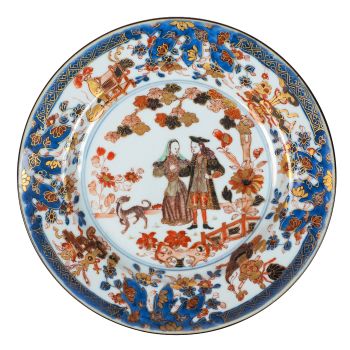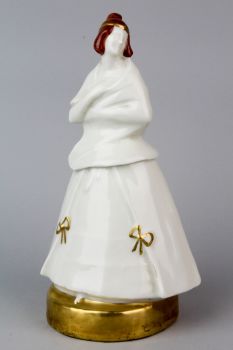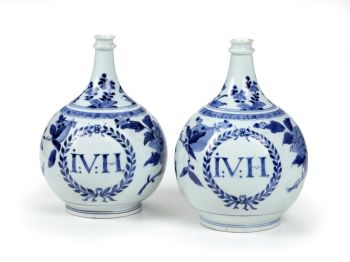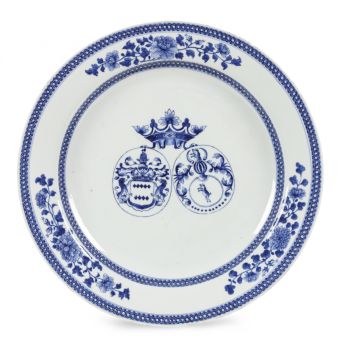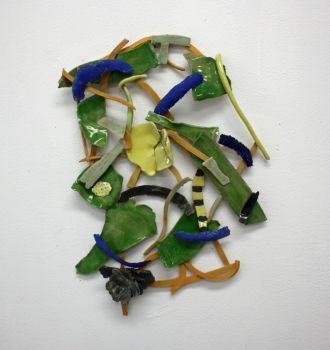Two Chinese porcelain famille rose Mancerina plates, Qianlong Qing dynasty c. 1770 Chinese export di 1770
Onbekende Kunstenaar
PorseleinChinees porselein
3.50 ⨯ 21.50 ⨯ 21.60 cm
ConditionGood
Prijs op aanvraag
Menken Works of Art
- Over kunstwerkA pair of two famille rose trembleuse stands or chocolate cup holders for the Spanish and Mexican market, ‘mancerina’.
China, Qianlong period, c. 1770.
The mancerina of molded scallop shell form, on raised feet with refined overglaze hand painted famille rose decorations.
These ornate, unusually large saucers with a cupholder in the centre (which are missing in this case) were special pieces made for serving chocolate. It was invented by a Spanish grandee, in Mexico, in the seventeenth century and was named after the man who had invented it, Pedro de Toledo, 1st Marquis of Mancera, who served as Viceroy of Peru from 1639 to 1648.
Called mancerina, the cup holders were designed to catch spilled liquid and help the drinker avoid burning their fingers on a hot cup. The tray could in turn be used to hold pastries. Mancerinas were first made in silver in colonial Mexico and Spain and later copied in ceramics, with models of these pieces sent to Chinese porcelain workshops.
In conclusion, these mancerina are a testament to colonial history and mutual influence between cultures connected via sea trade routes from West to East.
Dimensions (few mm varying in size):
Height 3.5 cm, width 21.5 cm, depth 21.6 cm.
Condition (DM for more pictures):
The first plate with two chips under the rim, the bottom with a star-shaped hairline in the middle (not showing on the top), the raised rim in the center on the top with a small scuff, furthermore in very good condition.
The second plate with a star-shaped hairline in the middle (also showing on the top) and a small hairline to the central border.
Identical mancerina with matching cup can be found in the following museum collections:
-Museo Nacional de Historia, Mexico City, illustrated by M. Priyadarshini, Chinese Porcelain in Colonial Mexico, p. 123, fig. 4.9.
-Carnegie Museum of Art, Pittsburgh, United States, accession no. 70.59.1
-Museum Amparo Puebla de Zaragoza, Mexico
-Museo Nacional del Virreinato, Tepotzotlán, Mexico
-Asian Civilisations Museum, 2022-00043
For a lecture in Spanish by Museo Amparo about this specific mancerina, click on the following link:
https://www.youtube.com/watch?app=desktop&v=T2exETvFg00
Also see:
https://www.youtube.com/watch?v=kJUmINIE1VQ
Inv. No: MW8 - Over kunstenaar
Het kan voorkomen dat een kunstenaar of maker onbekend is.
Voor sommige werken is het niet te bepalen door wie het gemaakt is of dat het is gemaakt door (een groep) ambachtslieden. Voorbeelden zijn beelden uit de Oudheid, meubels, spiegels of handtekeningen die vaak niet duidelijk of leesbaar zijn. Maar ook sommige werken zijn helemaal niet gesigneerd.
Ook kunt u de volgende beschrijving vinden:
•"Toegeschreven aan …." waarschijnlijk een werk van de kunstenaar maar niet zeker of gedeeltelijk
•“Atelier van ….” of werkplaats van” een werk uitgevoerd in het atelier of atelier van de kunstenaar, eventueel onder zijn toezicht
•“Cirkel van ….” een werk uit de periode van de kunstenaar die zijn invloed laat zien, nauw verbonden met de kunstenaar maar niet noodzakelijkerwijs zijn leerling
•“Stijl van ….” of “Volger van ….” een werk uitgevoerd in de stijl van de kunstenaar, maar niet noodzakelijk door een leerling; kan eigentijds of bijna eigentijds zijn
•“Wijze van ….” een werk in de stijl van de kunstenaar maar van latere datum
•"Na …." een kopie (van welke datum dan ook) van een werk van de kunstenaar
•“Getekend…”, “Gedateerd….” of “Ingeschreven” dan is het werk gesigneerd/ gedateerd/ ingeschreven door de kunstenaar. De toevoeging van een vraagteken duidt op een element van twijfel
•"Met handtekening ...", "Met datum ...", "Met opschrift..." of “Draagt signatuur/datum/opschrift” dan is de handtekening/datum/opschrift toegevoegd door iemand anders dan de kunstenaar
Bent u geïnteresseerd om dit kunstwerk te kopen?
Artwork details
Related artworks
- 1 - 4 / 12
Onbekende Kunstenaar
A Japanese bronze Hu flower vase, Edo / Meiji, 19th century19th century
Prijs op aanvraagMenken Works of Art
HUGO VILFRED VON PEDERSEN
Gadesanger fra Singapore (Musician from Singapore)1870 - 1959
Prijs op aanvraagZebregs & Röell - Fine Art - Antiques
1 - 4 / 16- 1 - 4 / 24
Onbekende Kunstenaar
Series of 6 Chinese cups and saucers (Yongzheng period)1722 - 1735
Prijs op aanvraagKuipers Kunst & Antiek
1 - 4 / 24Onbekende Kunstenaar
Chinese gilt bronze censer, Xuande mark, 18th century, Qing dynasty18th century
Prijs op aanvraagMenken Works of Art
Onbekende Kunstenaar
A Japanese bronze Hu flower vase, Edo / Meiji, 19th century19th century
Prijs op aanvraagMenken Works of Art
1 - 4 / 12















